Monitoring and Influencing Factors Analysis of Urban Vegetation Changes in the Plateau-Mountainous City
Abstract
1. Introduction
2. Materials and Methods
2.1. Study Area
2.2. Data Sources
2.3. Research Methods
2.3.1. Establishment of the kNDVI Dataset
2.3.2. Trend Analysis
2.3.3. Stability Analysis
2.3.4. GDM Analysis
3. Results
3.1. Spatio-Temporal Variations in kNDVI
3.1.1. Interannual Variations in kNDVI
3.1.2. Monthly Variations in kNDVI
3.1.3. Regional Changes in kNDVI
3.2. Stability Analysis of kNDVI
3.3. Trends Analysis of kNDVI
3.4. GDM Analysis of kNDVI
4. Discussion
5. Conclusions
- (1)
- The kNDVI in Kunming City demonstrated a favorable condition and exhibited an upward trend, with an annual growth rate of 2.4% per decade. Areas with high kNDVI (0.571–0.691) account for 30.2% of the total area of Kunming, indicating overall good vegetation status.
- (2)
- Over the past 24 years, approximately 49.8% of the area in Kunming has seen significant improvement, which is significantly greater than the 19.3% of the area experiencing vegetation degradation. Spatial heterogeneity is reflected in vegetation fluctuation characteristics. Areas with larger fluctuations tend to be more densely populated, while regions with smaller fluctuations are mainly forested areas.
- (3)
- The detection results for the influencing factors reveal that soil type has an average explanatory power of 29.5% over a five-year period and is the primary influencing factor. Landform type, nighttime light, and slope are secondary influencing factors. The interactions among factors exhibit greater explanatory power than individual factors independently. They indicate a bivariate enhanced and nonlinear enhancement relationship when two factors act in combination.
Author Contributions
Funding
Data Availability Statement
Acknowledgments
Conflicts of Interest
References
- Fu, B.-J.; Wang, S.; Liu, Y.; Liu, J.; Liang, W.; Miao, C. Hydrogeomorphic Ecosystem Responses to Natural and Anthropogenic Changes in the Loess Plateau of China. Annu. Rev. Earth Planet. Sci. 2017, 45, 223–243. [Google Scholar] [CrossRef]
- Hua, W.; Chen, H.; Zhou, L.; Xie, Z.; Qin, M.; Li, X.; Ma, H.; Huang, Q.; Sun, S. Observational Quantification of Climatic and Human Influences on Vegetation Greening in China. Remote Sens. 2017, 9, 425. [Google Scholar] [CrossRef]
- Ding, Z.; Peng, J.; Qiu, S.; Zhao, Y. Nearly Half of Global Vegetated Area Experienced Inconsistent Vegetation Growth in Terms of Greenness, Cover, and Productivity. Earth’s Future 2020, 8, e2020EF001618. [Google Scholar] [CrossRef]
- Bonan, G.; Pollard, D.; Thompson, S. Effects of Boreal Forest Vegetation on Global Climate. Nature 1992, 359, 716–718. [Google Scholar] [CrossRef]
- Chen, C.; Park, T.; Wang, X.; Piao, S.; Xu, B.; Chaturvedi, R.; Fuchs, R.; Brovkin, V.; Ciais, P.; Fensholt, R.; et al. China and India Lead in Greening of the World through Land-Use Management. Nat. Sustain. 2019, 2, 122–129. [Google Scholar] [CrossRef]
- Liu, H.; Zhang, M.; Lin, Z.; Xu, X. Spatial Heterogeneity of the Relationship between Vegetation Dynamics and Climate Change and Their Driving Forces at Multiple Time Scales in Southwest China. Agric. For. Meteorol. 2018, 256–257, 10–21. [Google Scholar] [CrossRef]
- Xie, B.; Jia, X.; Qin, Z.; Shen, J.; Chang, Q. Vegetation Dynamics and Climate Change on the Loess Plateau, China: 1982–2011. Reg. Environ. Change 2016, 16, 1583–1594. [Google Scholar] [CrossRef]
- Xue, Y.; Zhang, B.; He, C.; Shao, R. Detecting Vegetation Variations and Main Drivers over the Agropastoral Ecotone of Northern China through the Ensemble Empirical Mode Decomposition Method. Remote Sens. 2019, 11, 1860. [Google Scholar] [CrossRef]
- Hu, M.; Xia, B. A Significant Increase in the Normalized Difference Vegetation Index during the Rapid Economic Development in the Pearl River Delta of China. Land Degrad. Dev. 2019, 30, 359–370. [Google Scholar] [CrossRef]
- Fensholt, R.; Proud, S.R. Evaluation of Earth Observation Based Global Long Term Vegetation Trends—Comparing GIMMS and MODIS Global NDVI Time Series. Remote Sens. Environ. 2012, 119, 131–147. [Google Scholar] [CrossRef]
- Jiao, W.; Wang, L.; Smith, W.; Chang, Q.; Wang, H.; D’Odorico, P. Observed Increasing Water Constraint on Vegetation Growth over the Last Three Decades. Nat. Commun. 2021, 12, 3777. [Google Scholar] [CrossRef]
- Gao, X.; Huete, A.R.; Ni, W.; Miura, T. Optical–Biophysical Relationships of Vegetation Spectra without Background Contamination. Remote Sens. Environ. 2000, 74, 609–620. [Google Scholar] [CrossRef]
- Alencar, A.; Shimbo, J.Z.; Lenti, F.; Balzani Marques, C.; Zimbres, B.; Rosa, M.; Arruda, V.; Castro, I.; Fernandes Márcico Ribeiro, J.P.; Varela, V.; et al. Mapping Three Decades of Changes in the Brazilian Savanna Native Vegetation Using Landsat Data Processed in the Google Earth Engine Platform. Remote Sens. 2020, 12, 924. [Google Scholar] [CrossRef]
- Thenkabail, P.S.; Smith, R.B.; De Pauw, E. Hyperspectral Vegetation Indices and Their Relationships with Agricultural Crop Characteristics. Remote Sens. Environ. 2000, 71, 158–182. [Google Scholar] [CrossRef]
- Camps-Valls, G.; Campos-Taberner, M.; Moreno, A.; Walther, S.; Duveiller, G.; Cescatti, A.; Mahecha, M.; Muñoz, J.; García-Haro, F.; Guanter, L.; et al. A Unified Vegetation Index for Quantifying the Terrestrial Biosphere. Sci. Adv. 2021, 7, eabc7447. [Google Scholar] [CrossRef]
- Feng, X.; Tian, J.; Wang, Y.; Wu, J.; Liu, J.; Ya, Q.; Li, Z. Spatio-Temporal Variation and Climatic Driving Factors of Vegetation Coverage in the Yellow River Basin from 2001 to 2020 Based on kNDVI. Forests 2023, 14, 620. [Google Scholar] [CrossRef]
- Zhao, L.; Dai, A.; Dong, B. Changes in Global Vegetation Activity and Its Driving Factors during 1982–2013. Agric. For. Meteorol. 2018, 249, 198–209. [Google Scholar] [CrossRef]
- Zhao, Y.; Feng, Q.; Lu, A. Spatiotemporal Variation in Vegetation Coverage and Its Driving Factors in the Guanzhong Basin, NW China. Ecol. Inform. 2021, 64, 101371. [Google Scholar] [CrossRef]
- Jiang, H.; Xu, X.; Zhang, T.; Xia, H.; Huang, Y.; Qiao, S. The Relative Roles of Climate Variation and Human Activities in Vegetation Dynamics in Coastal China from 2000 to 2019. Remote Sens. 2022, 14, 2485. [Google Scholar] [CrossRef]
- Wang, J.-F.; Zhang, T.-L.; Fu, B.-J. A Measure of Spatial Stratified Heterogeneity. Ecol. Indic. 2016, 67, 250–256. [Google Scholar] [CrossRef]
- Zhang, C.; Bai, Z.; Li, X.; Rang, Q.; Wei, Z.; Lei, T.; Wang, N. Spatio-temporal evolution and attribution analysis of human effects of vegetation cover on the Loess Plateau from 2001 to 2018. Arid. Land Geogr. 2021, 44, 188–196. [Google Scholar]
- Liu, Z.; Hu, W.; Ma, L.; Huang, X. Spatio-Temporal Variations of Vegetation Cover and Its Influencing Factors in Highland Lake Basin. Front. Environ. Sci. 2024, 12, 1502208. [Google Scholar] [CrossRef]
- Zhang, S.; Nie, Y.; Zhang, H.; Li, Y.; Han, Y.; Liu, Y.; Wang, B. Spatiotemporal Variation of Vegetation NDVI and its Driving Forces in Inner Mongolia Based on Geodetector. Acta Agrestia Sin. 2020, 28, 1460–1472. [Google Scholar]
- He, J.; Zhang, M.; Wang, P.; Wang, S.; Wang, X. Climate Characteristics of the Extreme Drought Events in Southwest China during Recent 50 Years. Acta Geogr. Sin. 2011, 66, 1179–1190. [Google Scholar]
- Fensholt, R.; Langanke, T.; Rasmussen, K.; Reenberg, A.; Prince, S.D.; Tucker, C.; Scholes, R.J.; Le, Q.B.; Bondeau, A.; Eastman, R.; et al. Greenness in Semi-Arid Areas across the Globe 1981–2007—An Earth Observing Satellite Based Analysis of Trends and Drivers. Remote Sens. Environ. 2012, 121, 144–158. [Google Scholar] [CrossRef]
- Mu, B.; Zhao, X.; Wu, D.; Wang, X.; Zhao, J.; Wang, H.; Zhou, Q.; Du, X.; Liu, N. Vegetation Cover Change and Its Attribution in China from 2001 to 2018. Remote Sens. 2021, 13, 496. [Google Scholar] [CrossRef]
- Li, C.; Jia, X.; Zhu, R.; Mei, X.; Wang, D.; Zhang, X. Seasonal Spatiotemporal Changes in the NDVI and Its Driving Forces in Wuliangsu Lake Basin, Northern China from 1990 to 2020. Remote Sens. 2023, 15, 2965. [Google Scholar] [CrossRef]
- Cao, Y.; Zhou, S.; Yang, X. Vegetation dynamics and its response to climate change in Liaoning Province in last 20 years. Acta Ecol. Sin. 2022, 42, 5966–5979. [Google Scholar] [CrossRef]
- Chaudhari, K.; Thakkar, A. Neural Network Systems with an Integrated Coefficient of Variation-Based Feature Selection for Stock Price and Trend Prediction. Expert Syst. Appl. 2023, 219, 119527. [Google Scholar] [CrossRef]
- Deng, X.; Liu, Y.; Liu, Z.; Yao, J. Temporal-spatial dynamic change characteristics of evapotranspiration in arid region of Northwest China. Acta Ecol. Sin. 2017, 37, 2994–3008. [Google Scholar] [CrossRef][Green Version]
- Wang, J.-F.; Hu, Y. Environmental Health Risk Detection with GeogDetector. Environ. Model. Softw. 2012, 33, 114–115. [Google Scholar] [CrossRef]
- Sun, G.; Guo, B.; Zang, W.; Huang, X.; Han, B.; Yang, X.; Chen, S.; Wei, C.; Wu, H. Spatial–Temporal Change Patterns of Vegetation Coverage in China and Its Driving Mechanisms over the Past 20 Years Based on the Concept of Geographic Division. Geomat. Nat. Hazards Risk 2020, 11, 2263–2281. [Google Scholar] [CrossRef]
- Zhang, H.; Zhu, C.; Jiao, T.; Luo, K.; Xu, M.; Wang, M. Analysis of the Trends and Driving Factors of Cultivated Land Utilization Efficiency in Henan Province from 2000 to 2020. Land 2024, 13, 2109. [Google Scholar] [CrossRef]
- Zhu, Z.; Piao, S.; Myneni, R.; Huang, M.; Zeng, Z.; Canadell, J.; Ciais, P.; Sitch, S.; Friedlingstein, P.; Arneth, A.; et al. Greening of the Earth and Its Drivers. Nat. Clim. Change 2016, 6, 791–795. [Google Scholar] [CrossRef]
- Zhu, L.; Meng, J.; Zhu, L. Applying Geodetector to Disentangle the Contributions of Natural and Anthropogenic Factors to NDVI Variations in the Middle Reaches of the Heihe River Basin. Ecol. Indic. 2020, 117, 106545. [Google Scholar] [CrossRef]
- Huang, S.; Zheng, X.; Ma, L.; Wang, H.; Huang, Q.; Leng, G.; Meng, E.; Guo, Y. Quantitative Contribution of Climate Change and Human Activities to Vegetation Cover Variations Based on GA-SVM Model. J. Hydrol. 2020, 584, 124687. [Google Scholar] [CrossRef]
- Huo, H.; Sun, C. Spatiotemporal Variation and Influencing Factors of Vegetation Dynamics Based on Geodetector: A Case Study of the Northwestern Yunnan Plateau, China. Ecol. Indic. 2021, 130, 108005. [Google Scholar] [CrossRef]
- Li, H.; Li, Y.; Shen, W.; Li, Y.; Lin, J.; Lu, X.; Xu, X.; Jiang, J. Elevation-Dependent Vegetation Greening of the Yarlung Zangbo River Basin in the Southern Tibetan Plateau, 1999–2013. Remote Sens. 2015, 7, 16672–16687. [Google Scholar] [CrossRef]
- Xu, M.; Ding, J.; Wang, T.; Lu, L.; Sun, H.; Zhang, F.; Cheng, X.; Nurmemet, I. A Pixel Dichotomy Coupled Linear Kernel-Driven Model for Estimating Fractional Vegetation Cover in Arid Areas from High-Spatial-Resolution Images. IEEE Trans. Geosci. Remote Sens. 2023, 61, 1–15. [Google Scholar] [CrossRef]
- Xiong, J.; Peng, C.; Cheng, W.; Li, W.; Liu, Z.; Fan, C.; Sun, H. Analysis of Vegetation Coverage Change in Yunnan Province Based on MODIS-NDVI. J. Geo-Inf. Sci. 2018, 20, 1830–1840. [Google Scholar] [CrossRef]
- Pan, Y. Research on Dynamic Early Warning of Urban Ecosystem Security in Yunnan Province. Master’s Thesis, Yunnan Normal University, Kunming, China, 2017. [Google Scholar]
- Yu, S.; Luo, Y.; Li, J. Climatology and changes of hourly precipitation with various intensities in Yunnan Province from 1982 to 2016. Torrential Rain Disasters 2020, 39, 363–371. [Google Scholar] [CrossRef]
- Tao, Y.; Zhang, W.; Duan, C.; Chen, Y.; Ren, J.; Xing, D.; He, Q. Climatic causes of continuous drought over Yunnan Province from 2009 to 2012. J. Yunnan Univ. 2014, 36, 866–874. [Google Scholar] [CrossRef]
- Xu, X.; Liu, J.; Zhou, X. Vegetation Classification and Coverage Based on RS/GIS Technology—A Case Study of Kunming City, Yunnan Province. For. Resour. Manag. 2019, 86–93. [Google Scholar] [CrossRef]
- Bian, L.; Ye, F.; Liu, S.; Wang, J.; Xu, J. Change Trend of Vegetation Cover in Kunming based on NDVI During 2001–2015. Shandong Agric. Sci. 2018, 50, 107–110. [Google Scholar] [CrossRef]
- Feng, X.; Zhang, X. Analysis of Vegetation Coverage Changes in Kunming from 2012 to 2021 Based on NDVI. Mod. Agric. 2022, 54–58. [Google Scholar] [CrossRef]
- Sun, H.; Wang, J.; Xiong, J.; Bian, J.; Jin, H.; Cheng, W.; Li, A. Vegetation Change and Its Response to Climate Change in Yunnan Province, China. Adv. Meteorol. 2021, 8857589. [Google Scholar] [CrossRef]
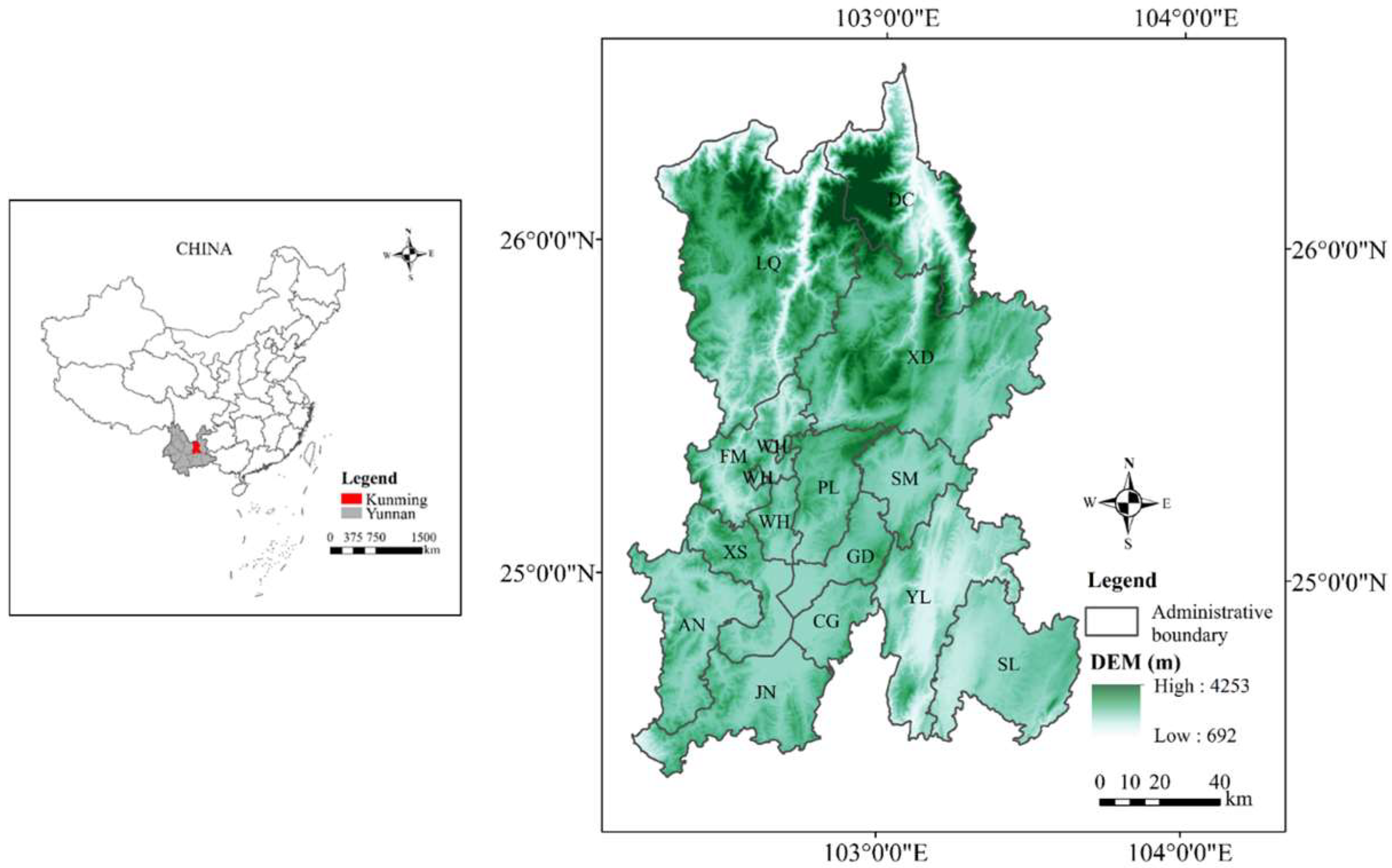
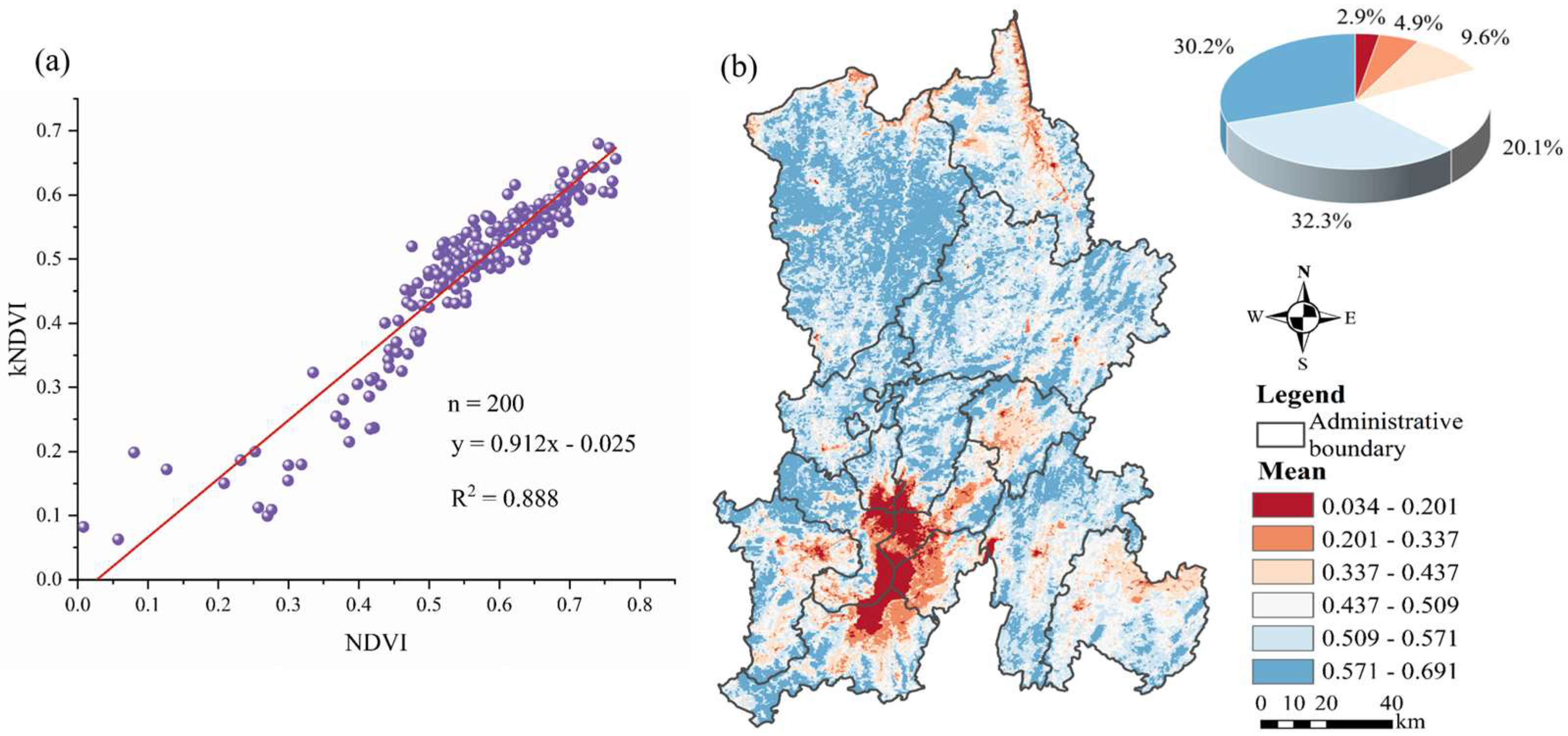
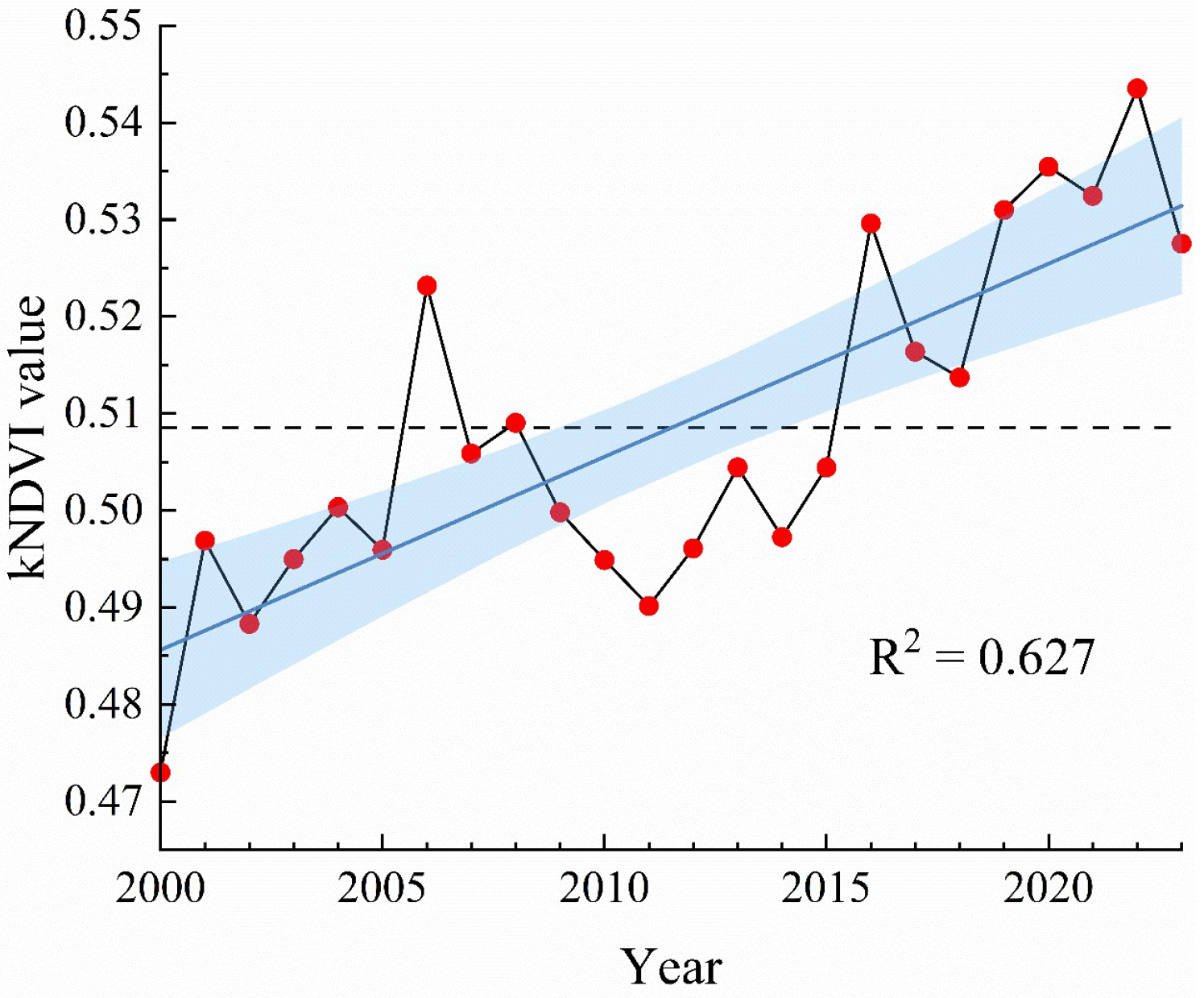
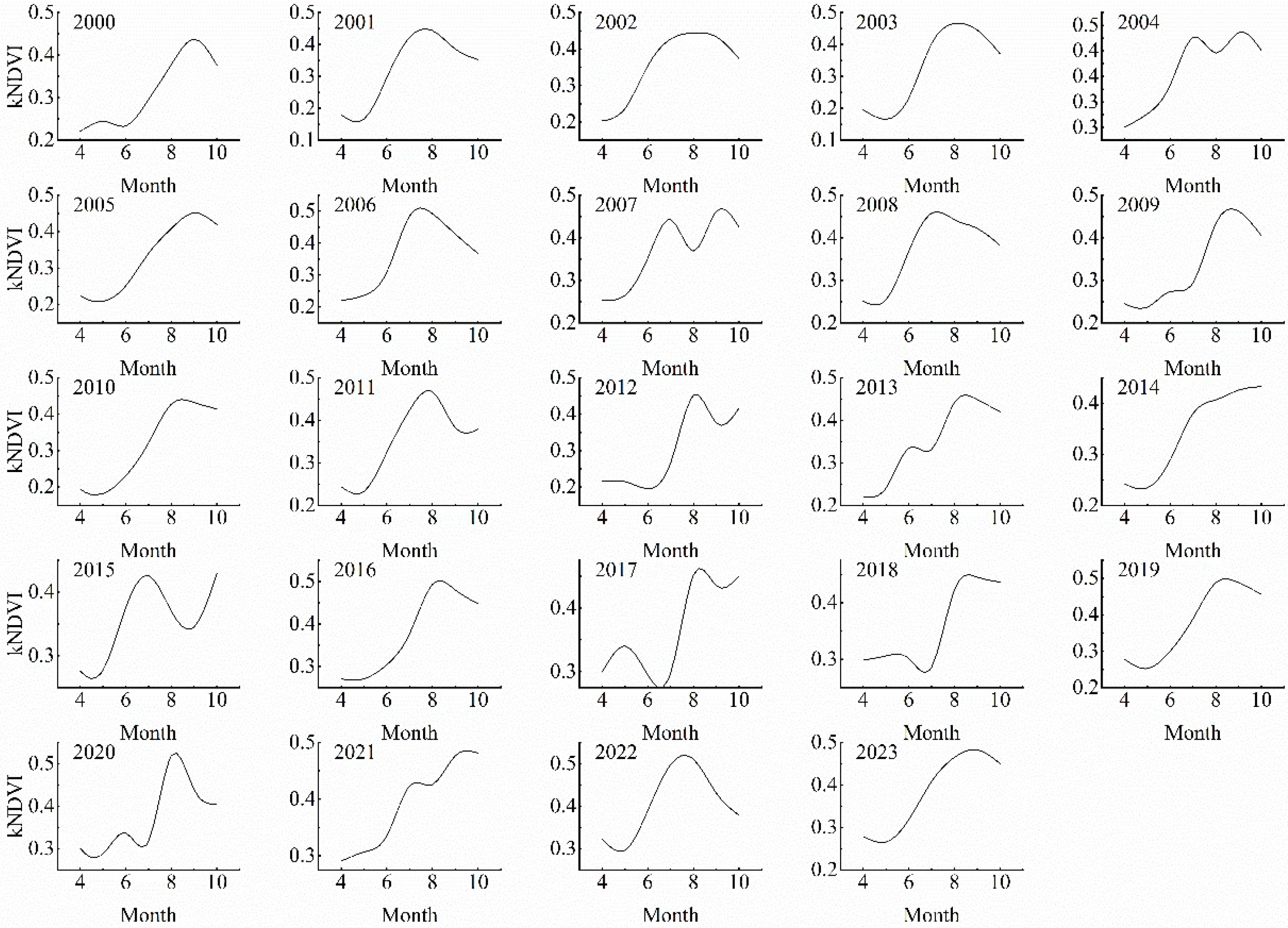
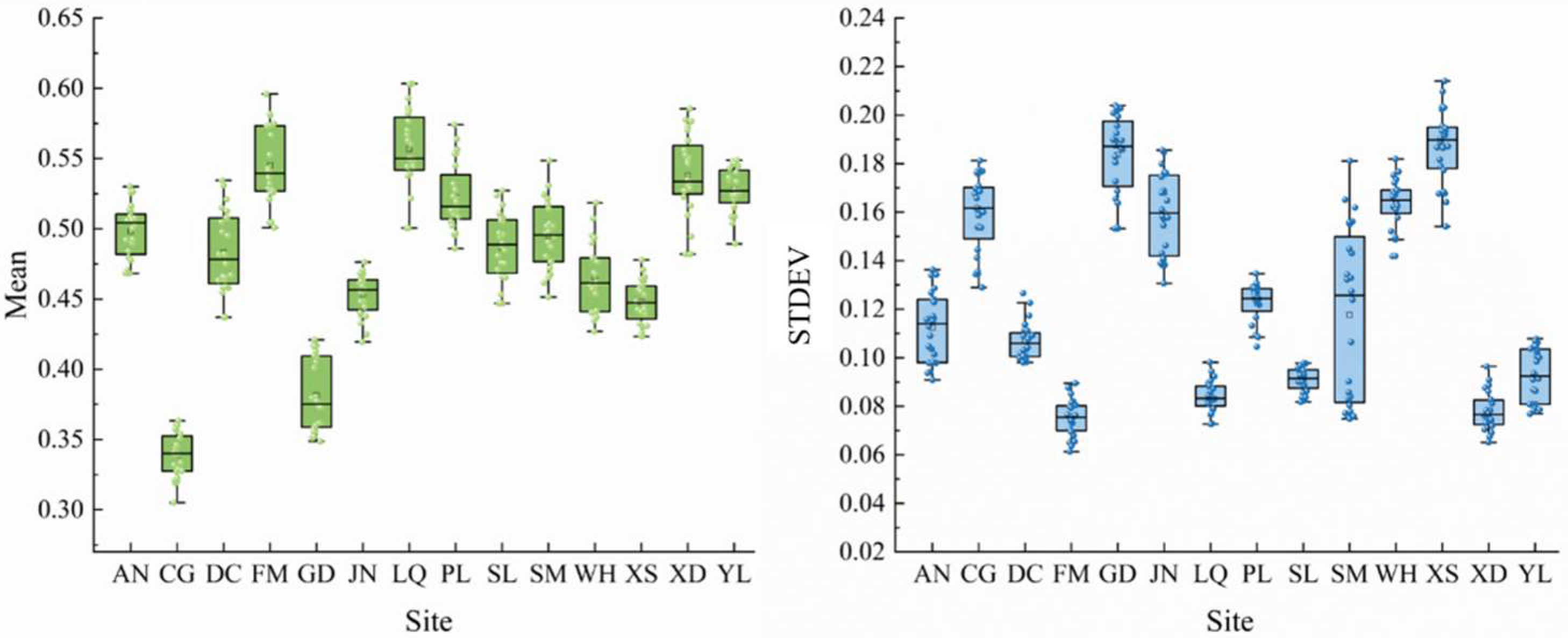
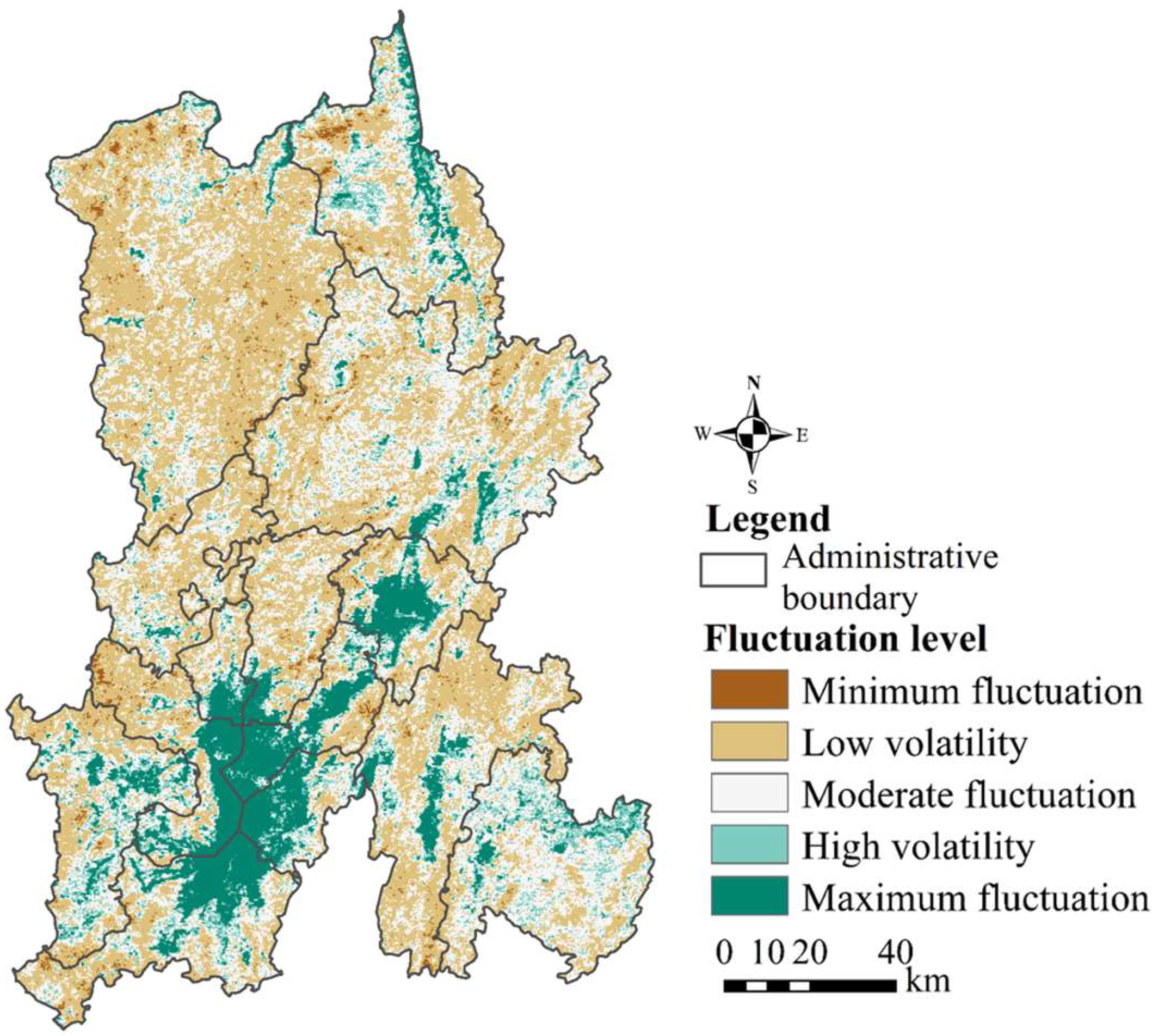
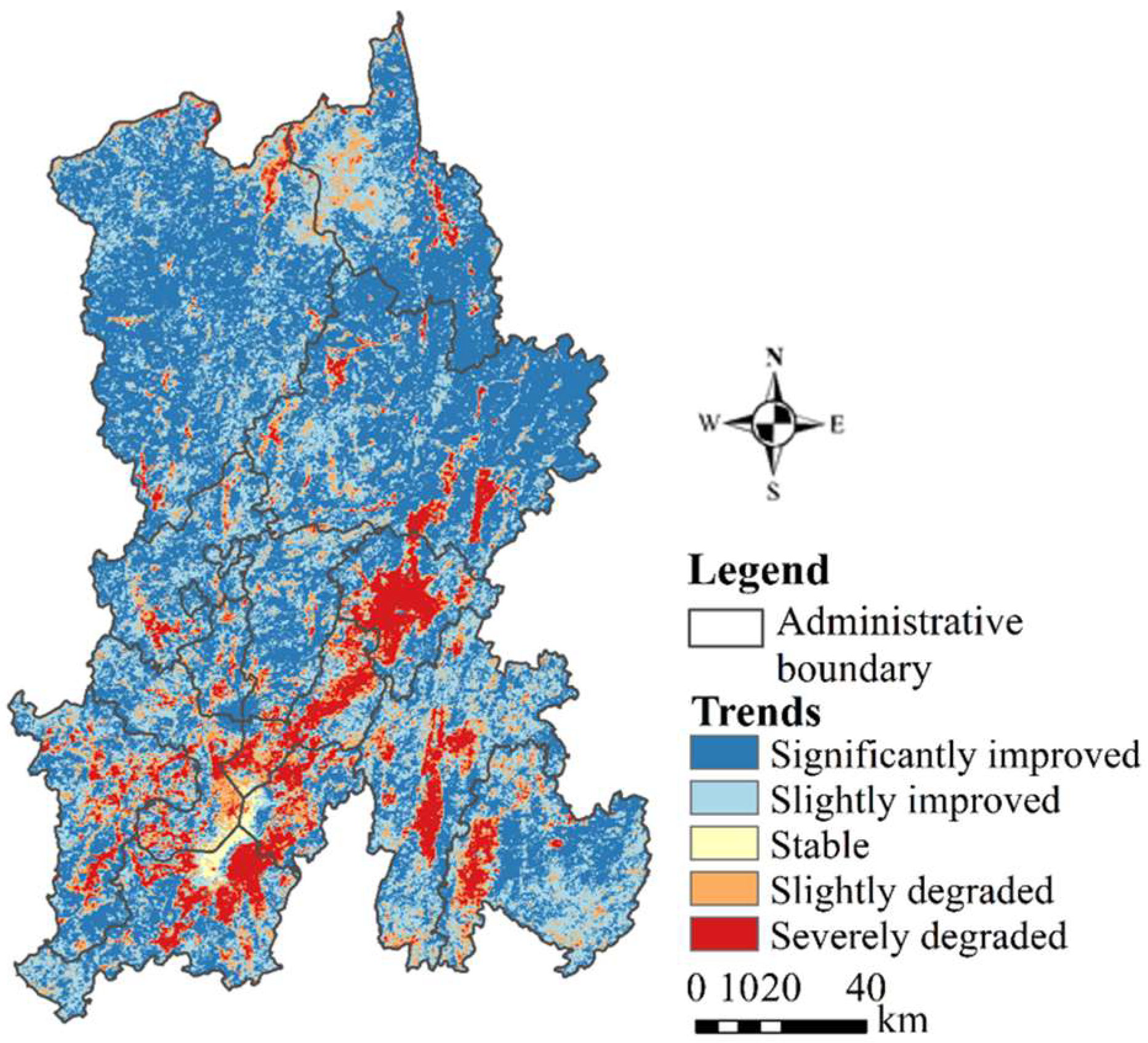
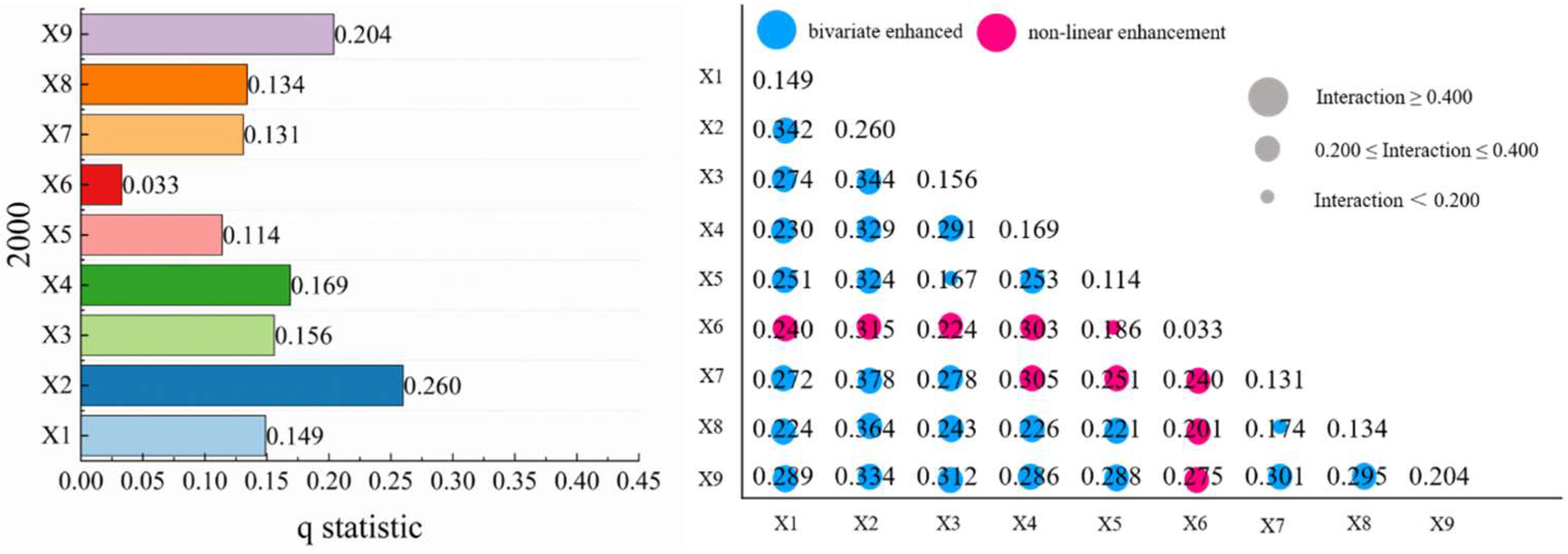

| Dataset | Data Sources | Spatial Resolution | Preprocessing |
|---|---|---|---|
| NDVI dataset | National Tibetan Plateau Data Center (https://data.tpdc.ac.cn/) | 250 m | Zoom out by 10,000 times |
| Slope (X1) | DEM | ||
| Soil (X2) | Data Centre for Resource and Environmental Sciences, Chinese Academy of Sciences (https://www.resdc.cn/) | 1 km | |
| DEM (X3) | Geospatial data cloud (https://www.gscloud.cn/) | 90 m | Resampling to 1 km |
| Geomorphological Atlas of the People’s Republic of China (X4) | National Earth System Science Data Center (https://www.geodata.cn/) | 1 km | |
| Average annual temperature (X5) | National Tibetan Plateau Data Center (https://data.tpdc.ac.cn/) | 1 km | |
| Annual precipitation (X6) | National Earth System Science Data Center (https://www.geodata.cn/) | 1 km | |
| GDP (X7) | National Earth System Science Data Center (https://www.geodata.cn/) | 1 km | |
| Artificial night light (X8) | National Tibetan Plateau Data Center (https://data.tpdc.ac.cn/) | 1 km | |
| Remote sensing monitoring data on the status of land use in China (X9) | Data Centre for Resource and Environmental Sciences, Chinese Academy of Sciences (https://www.resdc.cn/) | 30 m | Resampling to 1 km |
| β | Z | Trend Types |
|---|---|---|
| β > 0 | Z > 1.96 | Significantly improved |
| Z ≤ 1.96 | Slightly improved | |
| β = 0 | Z | Stable |
| β < 0 | Z ≤ 1.96 | Slightly degraded |
| Z > 1.96 | Severely degraded |
| Fluctuation Degree | CV Value | Area Ratio |
|---|---|---|
| Minimum fluctuation | <0.050 | 1.451% |
| Low volatility | 0.050 ≤ CV < 0.100 | 43.960% |
| Moderate fluctuation | 0.100 ≤ CV < 0.15 | 34.793% |
| High volatility | 0.150 ≤ CV < 0.200 | 8.794% |
| Maximum fluctuation | ≥0.200 | 11.002% |
Disclaimer/Publisher’s Note: The statements, opinions and data contained in all publications are solely those of the individual author(s) and contributor(s) and not of MDPI and/or the editor(s). MDPI and/or the editor(s) disclaim responsibility for any injury to people or property resulting from any ideas, methods, instructions or products referred to in the content. |
© 2025 by the authors. Licensee MDPI, Basel, Switzerland. This article is an open access article distributed under the terms and conditions of the Creative Commons Attribution (CC BY) license (https://creativecommons.org/licenses/by/4.0/).
Share and Cite
Liu, Z.; Wei, W.; Dong, Y.; Hu, W. Monitoring and Influencing Factors Analysis of Urban Vegetation Changes in the Plateau-Mountainous City. Forests 2025, 16, 1339. https://doi.org/10.3390/f16081339
Liu Z, Wei W, Dong Y, Hu W. Monitoring and Influencing Factors Analysis of Urban Vegetation Changes in the Plateau-Mountainous City. Forests. 2025; 16(8):1339. https://doi.org/10.3390/f16081339
Chicago/Turabian StyleLiu, Zhoujiang, Wentan Wei, Yifan Dong, and Wenxian Hu. 2025. "Monitoring and Influencing Factors Analysis of Urban Vegetation Changes in the Plateau-Mountainous City" Forests 16, no. 8: 1339. https://doi.org/10.3390/f16081339
APA StyleLiu, Z., Wei, W., Dong, Y., & Hu, W. (2025). Monitoring and Influencing Factors Analysis of Urban Vegetation Changes in the Plateau-Mountainous City. Forests, 16(8), 1339. https://doi.org/10.3390/f16081339







